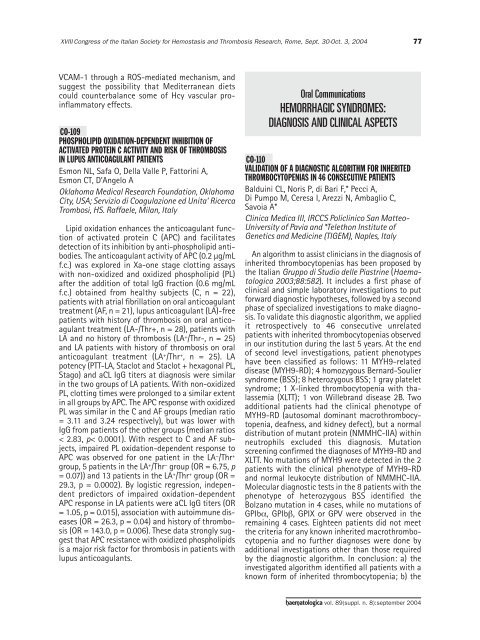Haematologica 2004;89: supplement no. 8 - Supplements ...
Haematologica 2004;89: supplement no. 8 - Supplements ...
Haematologica 2004;89: supplement no. 8 - Supplements ...
- No tags were found...
Create successful ePaper yourself
Turn your PDF publications into a flip-book with our unique Google optimized e-Paper software.
XVIII Congress of the Italian Society for Hemostasis and Thrombosis Research, Rome, Sept. 30-Oct. 3, <strong>2004</strong>77VCAM-1 through a ROS-mediated mechanism, andsuggest the possibility that Mediterranean dietscould counterbalance some of Hcy vascular proinflammatoryeffects.CO-109PHOSPHOLIPID OXIDATION-DEPENDENT INHIBITION OFACTIVATED PROTEIN C ACTIVITY AND RISK OF THROMBOSISIN LUPUS ANTICOAGULANT PATIENTSEsmon NL, Safa O, Della Valle P, Fattorini A,Esmon CT, D’Angelo AOklahoma Medical Research Foundation, OklahomaCity, USA; Servizio di Coagulazione ed Unita’ RicercaTrombosi, HS. Raffaele, Milan, ItalyLipid oxidation enhances the anticoagulant functio<strong>no</strong>f activated protein C (APC) and facilitatesdetection of its inhibition by anti-phospholipid antibodies.The anticoagulant activity of APC (0.2 µg/mLf.c.) was explored in Xa-one stage clotting assayswith <strong>no</strong>n-oxidized and oxidized phospholipid (PL)after the addition of total IgG fraction (0.6 mg/mLf.c.) obtained from healthy subjects (C, n = 22),patients with atrial fibrillation on oral anticoagulanttreatment (AF, n = 21), lupus anticoagulant (LA)-freepatients with history of thrombosis on oral anticoagulanttreatment (LA-/Thr+, n = 28), patients withLA and <strong>no</strong> history of thrombosis (LA + /Thr-, n = 25)and LA patients with history of thrombosis on oralanticoagulant treatment (LA + /Thr + , n = 25). LApotency (PTT-LA, Staclot and Staclot + hexagonal PL,Stago) and aCL IgG titers at diag<strong>no</strong>sis were similarin the two groups of LA patients. With <strong>no</strong>n-oxidizedPL, clotting times were prolonged to a similar extentin all groups by APC. The APC response with oxidizedPL was similar in the C and AF groups (median ratio= 3.11 and 3.24 respectively), but was lower withIgG from patients of the other groups (median ratios< 2.83, p< 0.0001). With respect to C and AF subjects,impaired PL oxidation-dependent response toAPC was observed for one patient in the LA − /Thr +group, 5 patients in the LA + /Thr − group (OR = 6.75, p= 0.07)) and 13 patients in the LA + /Thr + group (OR =29.3, p = 0.0002). By logistic regression, independentpredictors of impaired oxidation-dependentAPC response in LA patients were aCL IgG titers (OR= 1.05, p = 0.015), association with autoimmune diseases(OR = 26.3, p = 0.04) and history of thrombosis(OR = 143.0, p = 0.006). These data strongly suggestthat APC resistance with oxidized phospholipidsis a major risk factor for thrombosis in patients withlupus anticoagulants.Oral CommunicationsHEMORRHAGIC SYNDROMES:DIAGNOSIS AND CLINICAL ASPECTSCO-110VALIDATION OF A DIAGNOSTIC ALGORITHM FOR INHERITEDTHROMBOCYTOPENIAS IN 46 CONSECUTIVE PATIENTSBalduini CL, Noris P, di Bari F,* Pecci A,Di Pumpo M, Ceresa I, Arezzi N, Ambaglio C,Savoia A*Clinica Medica III, IRCCS Policlinico San Matteo-University of Pavia and *Telethon Institute ofGenetics and Medicine (TIGEM), Naples, ItalyAn algorithm to assist clinicians in the diag<strong>no</strong>sis ofinherited thrombocytopenias has been proposed bythe Italian Gruppo di Studio delle Piastrine (<strong>Haematologica</strong>2003;88:582). It includes a first phase ofclinical and simple laboratory investigations to putforward diag<strong>no</strong>stic hypotheses, followed by a secondphase of specialized investigations to make diag<strong>no</strong>sis.To validate this diag<strong>no</strong>stic algorithm, we appliedit retrospectively to 46 consecutive unrelatedpatients with inherited thrombocytopenias observedin our institution during the last 5 years. At the endof second level investigations, patient phe<strong>no</strong>typeshave been classified as follows: 11 MYH9-relateddisease (MYH9-RD); 4 homozygous Bernard-Souliersyndrome (BSS); 8 heterozygous BSS; 1 gray plateletsyndrome; 1 X-linked thrombocytopenia with thalassemia(XLTT); 1 von Willebrand disease 2B. Twoadditional patients had the clinical phe<strong>no</strong>type ofMYH9-RD (autosomal dominant macrothrombocytopenia,deafness, and kidney defect), but a <strong>no</strong>rmaldistribution of mutant protein (NMMHC-IIA) withinneutrophils excluded this diag<strong>no</strong>sis. Mutationscreening confirmed the diag<strong>no</strong>ses of MYH9-RD andXLTT. No mutations of MYH9 were detected in the 2patients with the clinical phe<strong>no</strong>type of MYH9-RDand <strong>no</strong>rmal leukocyte distribution of NMMHC-IIA.Molecular diag<strong>no</strong>stic tests in the 8 patients with thephe<strong>no</strong>type of heterozygous BSS identified theBolza<strong>no</strong> mutation in 4 cases, while <strong>no</strong> mutations ofGPIbα, GPIbβ, GPIX or GPV were observed in theremaining 4 cases. Eighteen patients did <strong>no</strong>t meetthe criteria for any k<strong>no</strong>wn inherited macrothrombocytopeniaand <strong>no</strong> further diag<strong>no</strong>ses were done byadditional investigations other than those requiredby the diag<strong>no</strong>stic algorithm. In conclusion: a) theinvestigated algorithm identified all patients with ak<strong>no</strong>wn form of inherited thrombocytopenia; b) thehaematologica vol. <strong>89</strong>(suppl. n. 8):september <strong>2004</strong>
















